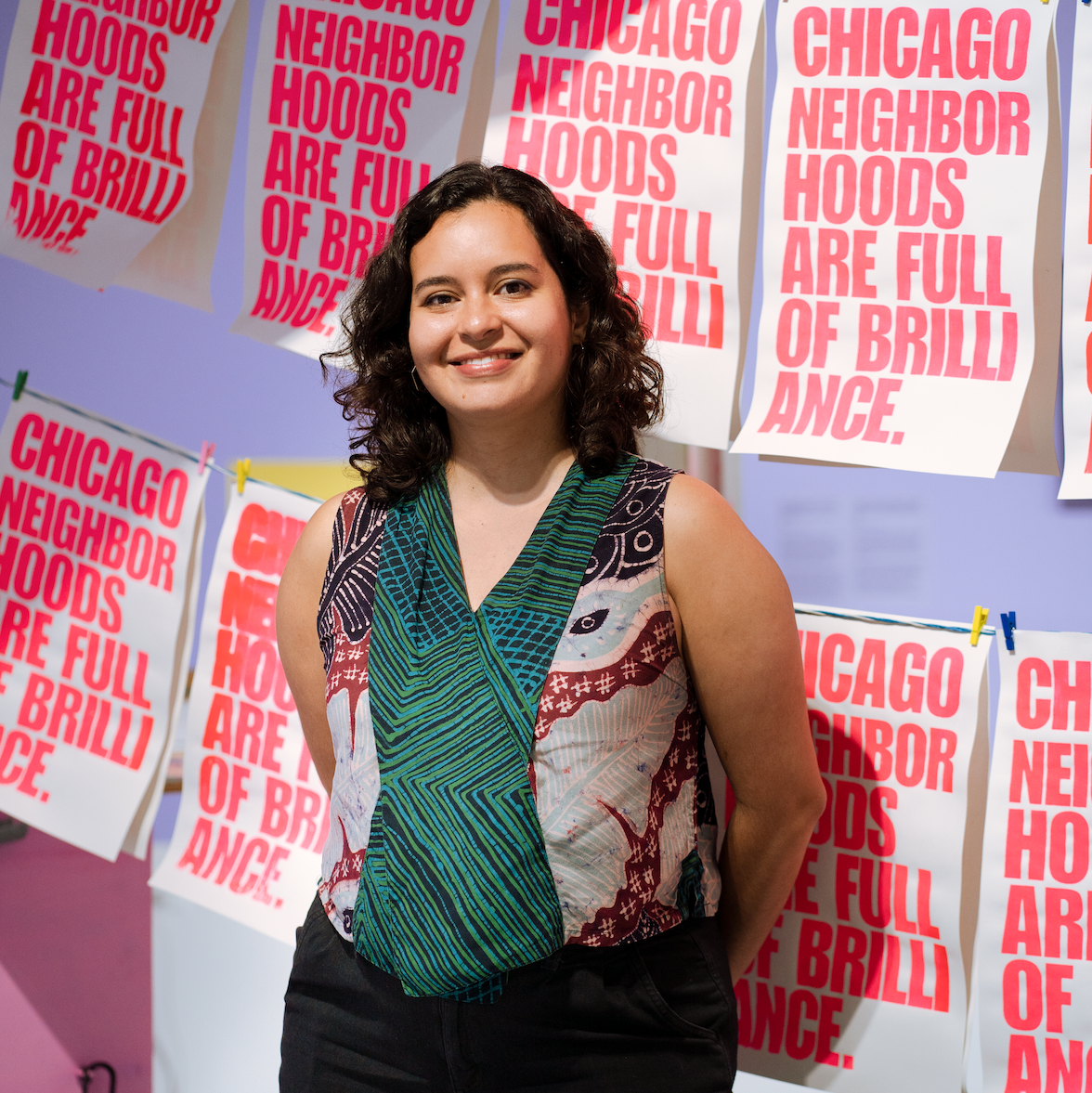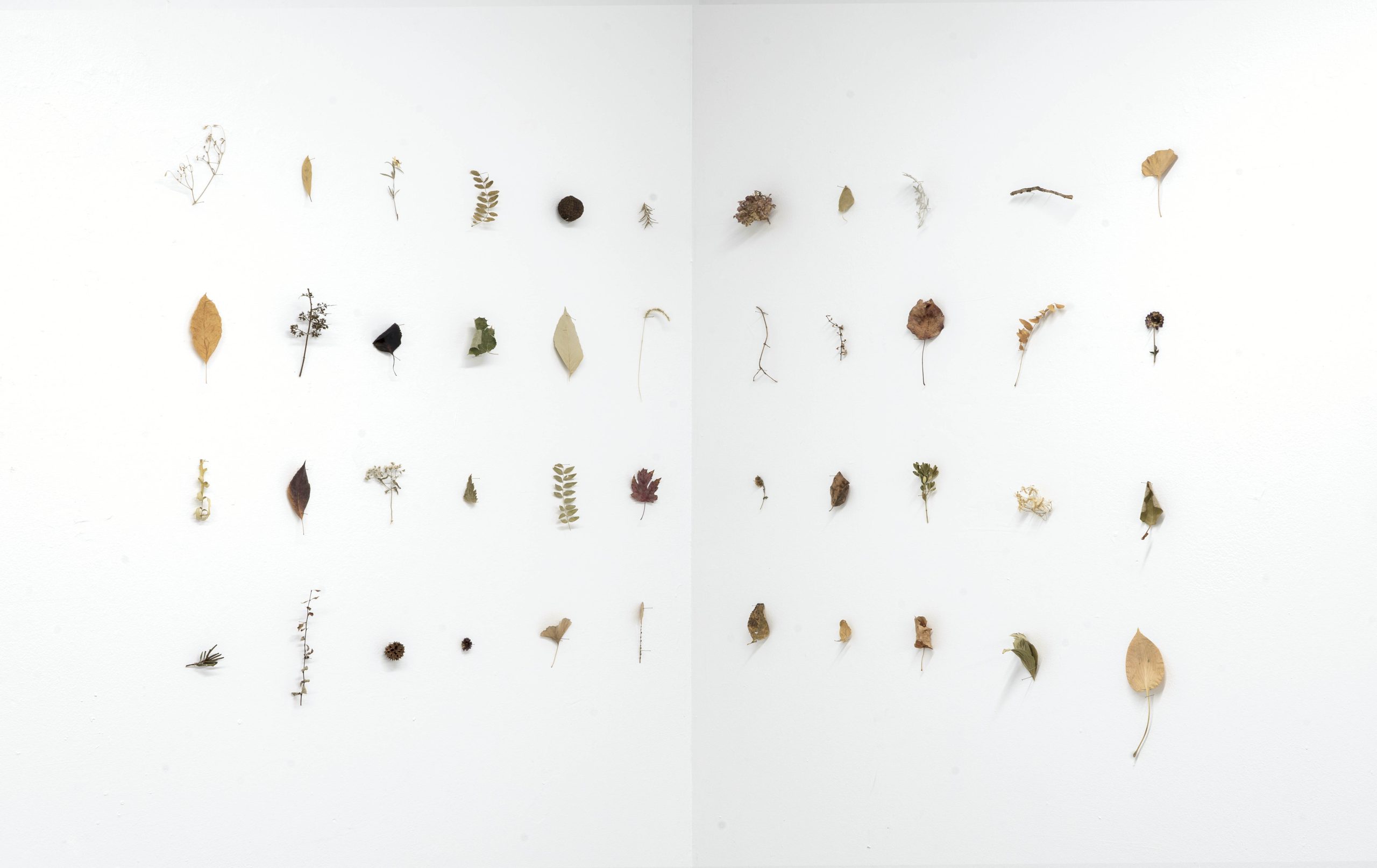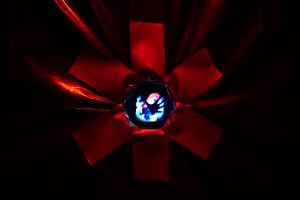
Para leer este artículo en Español, presione aqui.
Born in Bogotá, Colombia, Mariana Noreña grew up surrounded by mountains and nature and developed a sensitivity toward the natural world, often searching for subtle shifts and traces that allowed her to learn from plants, rocks, and mountains. For Noreña, the landscape and materials she finds in it are the starting point for an artistic practice through which she investigates and questions the histories of a place and her own relationship with her surroundings. Having learned how to use plants and other natural elements in her artistic practice, she began to use natural dyes for her textile art practice. Noreña migrated to Chicago three years ago and in the following interview she shares her experience of choosing to leave the lands that inspired her work for many years—and the effect this decision has had on her life and practice. We also talked about her most recent work currently on view at Murmuration, a new artist-run gallery in Chicago’s Humboldt Park neighborhood.

Mariela Acuña: Would you like to start by describing your relationship with landscape and how it manifests itself in your work?
Mariana Noreña: I grew up in a landscape defined by the Andes. I have always been attracted to landscapes and how they change over time. My practice is grounded in the contemplation of fluctuations between my body and my surroundings. I use my body as a vessel through which emotions can travel to turn into installations, sculptures, and textiles to materialize intimate environments. I constantly think of the landscape as an anatomical body that feels and has gestures. When I talk about landscape, I refer to both the natural landscape and also to the place where I am.
My longing to deepen my relationship to the landscape heightened once I moved to Chicago. When I lived in Colombia, all my works were about the natural world. I started making drawings of the plants in my garden. Later, I started to grow plants in my garden to make natural dyes. For years, I created representations of mountains, their clouds, and changes: inevitably, slowly. I was trying to notice changes, both fast and slow and trying to emulate those changes in my artwork. When I moved to Chicago, a lot of people asked me what’s going to happen in my work because Chicago is not a place that’s known for having a lot of nature. And I think that was one of the biggest questions I had when I arrived.
“Eventually, I realized that I didn’t have to focus only on nature and using natural materials, but what interested me is how a space feels. So I began to notice things like the overwhelming amount of metal and concrete and how those materials looked in relation with the natural materials, telling stories about the past and present of places.”
MA: Tell me more about that moment. How did your work adapt to your new environment?
MN: The first artwork that I made in Chicago was called Walking Home. It began in late summer with the intention of getting acquainted with the place and the paths that led me to my house, so I walked to my house for an hour or two and collected plants that I came across. Back in my studio, I observed these plants and arranged them. As organic materials change, the pieces are—like myself, my emotions, and nature—in constant flux.
Eventually, I realized that I didn’t have to focus only on nature and using natural materials, but what interested me is how a space feels. So I began to notice things like the overwhelming amount of metal and concrete and how those materials looked in relation with the natural materials, telling stories about the past and present of places.
Lately, I’ve been interested in learning about places, landscapes, and natural phenomena through earth matter and found materials that speak of past and present histories. This is also a practice of grounding myself and meditation, trying to understand my place in the space where I am, but also how that place is functioning in its different timelines, long and short. Like the mountains.

MA: You touched on a lot of interesting topics. I was struck by how you talked about time, about changes that pass slowly and noticing those small changes. And I find it interesting to think about time in relation to getting to know a new place. Your relationship with Colombian landscapes is intimate so your perception of the place is very different from a place you are starting to get familiar with.
MN: In Bogotá, I didn’t have the need to recognize the place or to find my place, my position in this place which was what happened to me in Chicago when I arrived. Speaking of time, those slow and fast changes became very evident at the time when I moved to Chicago. In Colombia, I looked at the mountains, and because we don’t have seasons, the changes I could see happened very slowly. Years would go by without a really visible change. When I moved here everything changed very fast and also the angle of perspective changed a lot. I used to look at mountains from far away and now I was looking at what was right at my feet. Also that exercise of collecting leaves, seeds, branches, and stones became an exercise of holding onto some nature before winter arrived.
MA: I was also struck by how you talked about the materials you found in Chicago. Materials like concrete and metal, which are materials that you obviously find and recognize in Bogotá as well, but the way you saw them here is different.
MN: Yes, because it was a new place, I started to notice that more. In Bogotá, the metal and concrete were obviously there, but it didn’t catch my attention so I decided to focus on nature. Those man-made materials were something I always saw there, but they didn’t change, they were very static, but here it’s very different. This new interest started to open a lot of doors and, above all, questions: How do these very man-made materials intervene in the natural landscape? How do they change the experience of living in these landscapes? The lake here has a beach that is man-made and has concrete stairs that are superimposed and are an invitation for people to have a moment with the lake, but the experience is not as it would naturally be. So as I mentioned, now I am more interested in how those materials, both natural and man-made, tell stories. This has shifted my focus to a more research-based practice. I had always said that observation was my form of research, because one of the great ways of doing research was to sit and observe: to observe how I was feeling, to observe the landscape, to observe people passing by, to sit down and observe. And that is still present, but I feel that now I am finding that those little pieces of information that are around us are telling us about the places where we are. They tell us about the past but also about the present, and how places are changing, and how we are changing them.
“The works that I made for the exhibition were made using material ecology from this ecosystem—soil, quinoa seeds, blackberry leaves, pine wood, eucalyptus, and ash. My intention is to both grieve and honor the land and the ancestral knowledge that intertwines culture with ecology.”
MA: Give us an example of what that looks like in your practice?
MN: I have been researching the páramos for some time now. My current exhibition at Murmurations talks about an event that happened in Colombia in January of this year when a large portion of the páramos were burned due to drought. The páramos are the ecosystems below the glaciers in the Andes and they are unique, they exist only in Colombia and in few other places in the world. They collect a lot of water. All the plants there are endemic and, in Colombia, they play a key role, which is to give water to all of Bogotá and feed rivers that reach the Amazon. In the Amazon, this water is evaporated back into the atmosphere to make rivers of clouds in the sky feeding not only Colombian territories but regulating droughts around the world.
The works that I made for the exhibition were made using material ecology from this ecosystem—soil, quinoa seeds, blackberry leaves, pine wood, eucalyptus, and ash. My intention is to both grieve and honor the land and the ancestral knowledge that intertwines culture with ecology. The Muisca people were an indigenous civilization that extended through the east of Colombia. Their cosmogony spoke of the need to preserve the páramos, which they considered sacred places that protect and preserve the planet’s harmony. The Muisca people took care of the lagoons, mountains, forests, and rivers of the páramos, perceiving them as places with life, consciousness, and spirit. For the Muiscas, each plant and seed were symbolic. Quinoa represented fertility, abundance, and spiritual connection with nature. Corn represented life and the sun. The Muisca believed their gods had created the first human beings from corn, and they used corn in their rituals to ask for good harvests, protection, and prosperity. Both quinoa and corn are used in offerings for the gods as a token of gratitude and devotion and to guarantee the welfare of the land.
“For the Muiscas each plant and seed were symbolic. Quinoa represented fertility, abundance, and spiritual connection with nature. Corn represented life and the sun. The Muisca believed their gods had created the first human beings from corn, and they used corn in their rituals to ask for good harvests, protection, and prosperity.”
In the process of making the work for this exhibition, I found that my process was a way of grieving. I also hope that the artworks help more people remember and recognize ancestral knowledge and those who, for millennia, have had the wisdom we seem to lack to recognize: the importance of the páramos and mountains.

MA: It sounds very beautiful! I appreciate the different ways that materials operate in your works; they are a source of inspiration, a source of knowledge, you use materials to create other materials, and to tell stories. You are attentive to not only what they can do, physically, but also what they can represent.
MN: Yes, my work, The House That Lives Within Me/ La Casa Que Habita Dentro De Mi (2023), grew out of a question that had been on my mind since I arrived in Chicago: what is it to belong to a place and what is it to call it home? I began to find materials and also moments or gestures of place or places that made me feel at home. The work combines many of those materials into a multi-sensory installation.
“What is it to belong to a place and what is it to call it home? I began to find materials and also moments or gestures of place or places that made me feel at home. The work combines many of those materials into a multi-sensory installation.”
The work had rosemary because [when] I planted rosemary in my house in Colombia to make natural dyes, every time it rained it smelled like rosemary. So now the smell of rosemary reminds me of my house. You can step into the installation and hear the sound of the leaves of the tree in my house in Colombia. Through these materials, my intention was to invite the viewer to feel welcomed in a place. I wanted to invite others to experience my home through their senses—through the sound of trees and birds, the smell of rosemary, feel the texture of materials, and see light through a dome made of corn paper. I hoped that the installation invited a moment of introspection. In the spirit of the idea that our house is in us, isn’t it?

MA: Yes, like a snail. It’s such a migrant mentality. I have been a migrant my whole life and have been fortunate to feel at home in many very different places. This is partly why I appreciate how mindful you are about how to arrive at a new place and how to get to know it. This very gentle and curious attitude toward arriving somewhere new is reflected in your practice.
MN: Yes, exactly.
MA: It was interesting to me how quickly after you arrived in Chicago, this city became your home. Every time you talked about home in your work you referred to Chicago and you had just left Colombia. I don’t know if it was the first time you left from living in Bogotá?
MN: I think it was the need to not feel like a stranger, to not feel so foreign. And I think that unconsciously it was from that place of thinking that I carry my home inside me. Let’s say with that feeling. I think my attitude when I moved here was always that I came to set up my house, there was an intention to take care of it. I always gave a lot of importance to feeling at home, so it was very important for me to land on that and to realize it into something physical, which was my apartment. To give it love and to love it. To make it my home.

About the author: Mariela Acuña is an art administrator and curator from San José, Costa Rica currently based in Chicago. As Exhibitions and Residency Manager at Hyde Park Art Center, she stewards the Jackman Goldwasser Residency, curates exhibitions, manages the micro-publishing platform Green Lantern Press, and along with a team designed and administers the Artists Run Chicago Fund, a regranting initiative that distributes grants to artist-run platforms in Chicago. She holds a BA in Art History and a BFA in Sculpture from Florida Atlantic University and a dual MA in Art Administration and Public Policy and Art History, Theory, and Criticism from the School of the Art Institute of Chicago.



